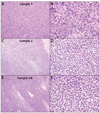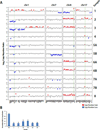Targeted next-generation sequencing of CIC-DUX4 soft tissue sarcomas demonstrates low mutational burden and recurrent chromosome 1p loss
- PMID: 27664537
- PMCID: PMC5125884
- DOI: 10.1016/j.humpath.2016.09.004
Targeted next-generation sequencing of CIC-DUX4 soft tissue sarcomas demonstrates low mutational burden and recurrent chromosome 1p loss
Abstract
Gene fusions between CIC and DUX4 define a rare class of soft tissue sarcomas poorly understood at the molecular level. Previous karyotyping and fluorescence in situ hybridization studies support chromosome 8 trisomy as a recurrent alteration; however, other driving alterations are largely unknown. Thus, we analyzed 11 formalin-fixed, paraffin-embedded CIC-DUX4 sarcoma tissue samples (including 3 sample pairs) using targeted Ion Torrent-based multiplexed polymerase chain reaction next-generation sequencing to characterize potential somatic driver alterations in 409 genes. Although we did not identify recurrent somatic mutations (point mutations or insertions/deletions), copy number analysis showed recurrent, broad copy number alterations, including gain of chromosome 8 and loss of 1p. In one sample pair (untreated primary and local recurrence resections), we identified similar copy number profiles and a somatic ARID1A R963X nonsense mutation exclusively in the local recurrence sample. In another sample pair (pre- and post-radiation treatment specimens), we observed single-copy loss of chromosome 7q exclusively in the posttreatment recurrence sample, supporting it as an acquired event after radiation treatment. In the last sample pair (near-concurrent, postchemotherapy primary and distant metastasis), molecular profiles were highly concordant, consistent with limited intertumoral heterogeneity. In summary, next-generation sequencing identified limited somatic driver mutations in CIC-DUX4 sarcomas. However, we identified novel, recurrent copy number alterations, including chromosome 1p, which is also the locus of ARID1A. Additional functional work and assessment of larger cohorts are needed to determine the biological and clinical significance of the alterations identified herein.
Keywords: ARID1A; CIC-DUX4; FFPE tissue; Next-generation sequencing; Soft tissue sarcoma.
Copyright © 2016 Elsevier Inc. All rights reserved.
Conflict of interest statement
Disclosures/Conflicts of Interest The remaining authors have no disclosures.
Figures



Similar articles
-
The CIC-DUX4 fusion transcript is present in a subgroup of pediatric primitive round cell sarcomas.Hum Pathol. 2012 Feb;43(2):180-9. doi: 10.1016/j.humpath.2011.04.023. Epub 2011 Aug 2. Hum Pathol. 2012. PMID: 21813156
-
Undifferentiated small round cell sarcoma with t(4;19)(q35;q13.1) CIC-DUX4 fusion: a novel highly aggressive soft tissue tumor with distinctive histopathology.Am J Surg Pathol. 2013 Sep;37(9):1379-86. doi: 10.1097/PAS.0b013e318297a57d. Am J Surg Pathol. 2013. PMID: 23887164
-
Superficial sarcomas with CIC rearrangement are aggressive neoplasms: A series of eight cases.J Cutan Pathol. 2020 Jun;47(6):509-516. doi: 10.1111/cup.13656. Epub 2020 Feb 18. J Cutan Pathol. 2020. PMID: 32026485
-
High-grade undifferentiated small round cell sarcoma with t(4;19)(q35;q13.1) CIC-DUX4 fusion: emerging entities of soft tissue tumors with unique histopathologic features--a case report and literature review.Am J Case Rep. 2015 Feb 16;16:87-94. doi: 10.12659/AJCR.892551. Am J Case Rep. 2015. PMID: 25683183 Free PMC article. Review.
-
New fusion sarcomas: histopathology and clinical significance of selected entities.Hum Pathol. 2019 Apr;86:57-65. doi: 10.1016/j.humpath.2018.12.006. Epub 2019 Jan 8. Hum Pathol. 2019. PMID: 30633925 Free PMC article. Review.
Cited by
-
Can a Liquid Biopsy Detect Circulating Tumor DNA With Low-passage Whole-genome Sequencing in Patients With a Sarcoma? A Pilot Evaluation.Clin Orthop Relat Res. 2025 Jan 1;483(1):39-48. doi: 10.1097/CORR.0000000000003161. Epub 2024 Jun 21. Clin Orthop Relat Res. 2025. PMID: 38905450
-
Upregulation of POLE and proficient DNA repair are features of CIC::DUX4 sarcomas.NPJ Precis Oncol. 2025 Jun 20;9(1):199. doi: 10.1038/s41698-025-00985-8. NPJ Precis Oncol. 2025. PMID: 40542203 Free PMC article.
-
Small round cell sarcoma tumoroid biobank reveals CIC::DUX4 sarcoma vulnerability to MCL-1 inhibition.Nat Commun. 2025 Aug 21;16(1):7689. doi: 10.1038/s41467-025-62673-2. Nat Commun. 2025. PMID: 40841360 Free PMC article.
-
Patient-derived tumoroids from CIC::DUX4 rearranged sarcoma identify MCL1 as a therapeutic target.Nat Commun. 2025 Aug 21;16(1):7688. doi: 10.1038/s41467-025-62629-6. Nat Commun. 2025. PMID: 40841513 Free PMC article.
-
A case report of CIC-DUX4 fusion-positive sarcoma in the pelvic cavity with targeted next-generation sequencing results.Front Oncol. 2022 Dec 15;12:1018992. doi: 10.3389/fonc.2022.1018992. eCollection 2022. Front Oncol. 2022. PMID: 36591446 Free PMC article.
References
-
- Davicioni E, Wai DH, Anderson MJ. Diagnostic and prognostic sarcoma signatures. Mol Diagn Ther. 2008;12:359–374. - PubMed
-
- Somers GR, Gupta AA, Doria AS, Ho M, Pereira C, Shago M, et al. Pediatric undifferentiated sarcoma of the soft tissues: a clinicopathologic study. Pediatr Dev Pathol. 2006;9:132–142. - PubMed
-
- Qualman SJ, Coffin CM, Newton WA, Hojo H, Triche TJ, Parham DM, et al. Intergroup Rhabdomyosarcoma Study: update for pathologists. Pediatr Dev Pathol. 1998;1:550–561. - PubMed
-
- Yoshimoto M, Graham C, Chilton-MacNeill S, Lee E, Shago M, Squire J, et al. Detailed cytogenetic and array analysis of pediatric primitive sarcomas reveals a recurrent CIC-DUX4 fusion gene event. Cancer Genet Cytogenet. 2009;195:1–11. - PubMed
Publication types
MeSH terms
Substances
Grants and funding
LinkOut - more resources
Full Text Sources
Other Literature Sources
Medical
Miscellaneous

